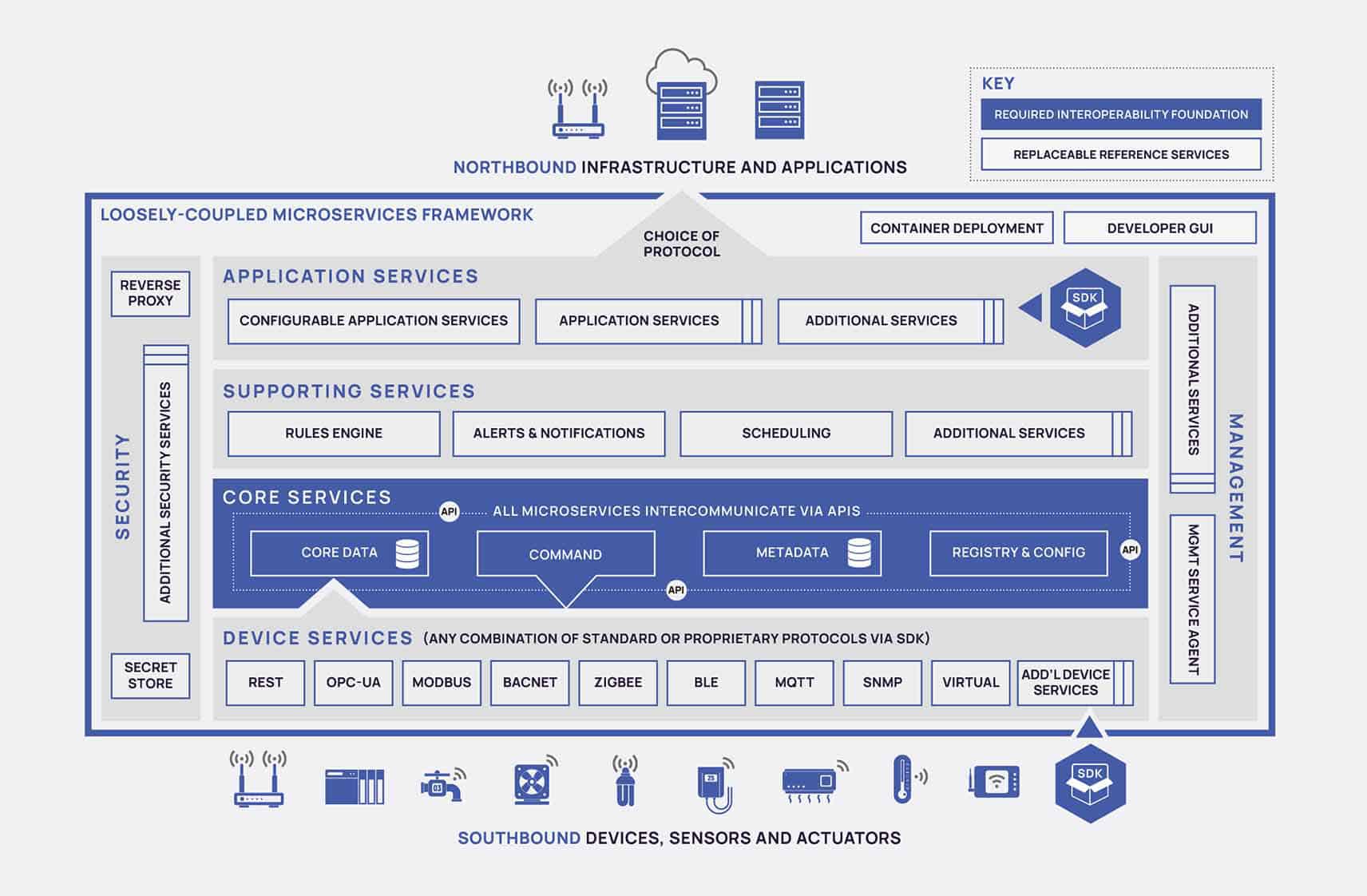EdgeX Foundry boosts device performance by deploying intelligence at the edge, using CPU and GPU resources effectively. It offers a range of benefits, and together with Ubuntu Core, is transforming the IoT landscape by bringing computing close to the data source.
IoT (Internet of Things) has sparked a revolution in various industries by interconnecting devices and facilitating data-driven decision-making. However, as the volume of IoT data escalates, challenges related to latency and bandwidth become increasingly evident. Edge computing, which processes data closer to its source, thus reducing latency and enhancing efficiency, addresses these issues. At the forefront of this transformative approach stands EdgeX Foundry, an open source framework.
While the concept of edge computing is undoubtedly intriguing, successfully implementing it can be a complex and intimidating endeavour. This is precisely where EdgeX Foundry emerges as a game-changing solution. This open source, vendor-neutral framework aims to streamline and standardise edge computing for IoT applications.
Now, let’s explore its notable advantages to understand what sets EdgeX Foundry apart from other solutions. There are several compelling reasons to consider it as your primary choice for an IoT edge computing platform.
Speed to market
In the fiercely competitive IoT space, speed to market can make or break a product. EdgeX Foundry accelerates development by providing a pre-built foundation with a comprehensive ecosystem of tools and resources, allowing developers to roll out innovative IoT solutions to market swiftly.
An open source powerhouse
EdgeX Foundry embodies the spirit of collaboration and innovation that defines the open source community. It operates under the Apache 2.0 open source licensing model, endorsed by the Linux Foundation’s LF Edge organisation. This open approach guarantees vendor neutrality. It also invites contributions from a global network of developers, ensuring that the platform remains robust and adaptable. It empowers not just developers but technology providers and end users alike to leverage the power of edge computing without any restrictions. The result? An ecosystem of ideas and solutions that benefit everyone involved.
Unmatched flexibility
With a modular architecture and a microservices-based framework, EdgeX Foundry offers unparalleled adaptability. IoT projects vary widely in requirements, and the flexibility and pluggable architecture of EdgeX plus the choice of hardware for the selection of communication protocols, allows for tailoring IoT solutions to the unique needs of various industries.
Focus on value addition
EdgeX Foundry isn’t just about data; it’s all about adding value. By bringing computing closer to the data source, it allows real-time analytics and decision-making. This shift not only boosts efficiency but also opens new opportunities, letting developers focus on solving real-world problems without worrying about the complexities of edge computing infrastructure.
![EdgeX platform architecture [Image credits: https://www.edgexfoundry.org/cmsfiles/image/Platform/edgex-platform-architecture-2.jpg]](https://www.opensourceforu.com/wp-content/uploads/2024/01/edgex-focused-at-the-iot-edge-2.jpg)
Cost reduction and risk mitigation
EdgeX Foundry helps realise cost savings in your cloud infrastructure and minimises data transfer expenses. The practice of processing data locally reduces the exposure to risks associated with transmitting sensitive data over networks. EdgeX Foundry not only reduces infrastructure costs but also enhances security and compliance by maintaining sensitive data within a localised environment.
Enabling innovation
Innovation is the heartbeat of EdgeX Foundry. Its open framework nurtures an ecosystem of compatible applications and services, igniting the imaginative sparks of developers. This spirit of innovation knows no bounds, enabling industries and organisations to modernise their operations, optimise processes, and deliver personalised real-time experiences through the power of IoT.
Realising edge computing benefits
Edge computing goes beyond mere tech buzz; it represents a groundbreaking shift that unveils a world of endless possibilities. In this transformative landscape, EdgeX Foundry takes centre stage as the key to unlocking the full potential of edge computing, especially in industries where lightning-fast data processing, ultra-low latency, unwavering reliability, and real-time decision-making are critical. Imagine it as having a cloud-based virtual machine right at the edge, revolutionising the rules of the entire game.
The EdgeX Foundry architecture
The architecture of EdgeX Foundry is the cornerstone of its success and is thoughtfully designed to maximise technological efficiency. It utilises a modular, microservices approach that ensures adaptability and scalability, much like a city with distinct buildings serving unique purposes. This architectural design streamlines data flow, remains platform-agnostic for seamless integration with diverse technologies, and establishes a secure foundation for data exchange and decision-making at the edge. It is a testament to EdgeX Foundry’s commitment to delivering a holistic solution for edge computing, akin to a well-planned city that accommodates the dynamic needs of its inhabitants and their varied requirements.
Platform agnosticism
EdgeX Foundry wholeheartedly embraces diversity. It doesn’t favour one platform over another, ensuring compatibility with a vast array of hardware from different OEMs and ODMs, a range of operating systems, cloud providers, and applications that span direct interfaces to sandboxed environments and containers. This platform agnosticism guarantees effortless integration into your current infrastructure, enabling businesses to adapt and innovate without the need for extensive overhauls.
Microservices flexibility
At the heart of EdgeX Foundry lies a microservices architecture that serves as a foundation for crafting nimble, scalable, and exceptionally flexible services. This adaptability empowers organisations to tailor their IoT solutions precisely to their needs, avoiding the confinement of rigid, monolithic applications. This approach ensures agility in a market that constantly evolves. It boasts support for containerisation, such as Docker or Snap, promoting application portability and simplifying deployment and orchestration. It facilitates the development of interoperable, plug-and-play edge software applications and value-added services.
Store and forward capability
EdgeX Foundry offers a crucial feature known as ‘store and forward capability’. This capability proves essential in situations where network connectivity is intermittent. It enables data to be temporarily stored at the edge, and when a stable connection is re-established, the data is efficiently forwarded, ensuring seamless operations.
Additionally, EdgeX Foundry optimises data handling by compressing historical data and eliminating redundant information within specific time intervals. This not only reduces the data size but also streamlines the process of collecting data from multiple IoT devices before performing computations for data transmission and storage.
Intelligence at the edge
EdgeX Foundry’s strategy of positioning intelligence at the edge serves as a solution to various critical concerns, including actuation latency, bandwidth constraints, storage limitations, and facilitating remote operations. This approach optimises performance and operational efficiency while also acting as a mini-monitor for IoT devices onsite. Furthermore, this intelligent edge placement allows for the effective utilisation of not only higher CPU compute power but also the efficient utilisation of GPU and AI-related CPU resources.

Brown and greenfield deployments
EdgeX Foundry’s architectural design inherently resolves critical interoperability challenges that arise at the convergence of various directions in a distributed IoT edge architecture. This ensures seamless integration with legacy systems, enabling the collection of data from existing sensors and controllers. Consequently, EdgeX Foundry eliminates the need for costly and disruptive infrastructure overhauls in projects such as smart building optimisation. The real-time processing and analysis of data from brownfield devices at the edge result in enhanced energy efficiency and increased occupant comfort.
Moreover, EdgeX Foundry’s capability to accommodate both brownfield and greenfield deployments simplifies the gradual expansion and modernisation of IoT systems while honouring existing infrastructure investments. This adaptability proves to be an invaluable asset in real-world applications, where IoT initiatives often comprise a mixture of legacy and cutting-edge technologies.
Security and manageability
EdgeX Foundry places a strong emphasis on security, offering the capability to process and store sensitive data locally, thereby significantly reducing the risk of potential security breaches. This approach empowers companies to enhance the protection of their critical edge data and devices. It enables on-premise data processing while allowing selective exposure of specific data and applications to the cloud, ensuring data security and compliance with industry regulations.
EdgeX Foundry doesn’t limit its focus to security alone; it also streamlines the management of widely distributed compute nodes and effectively scales down to accommodate highly-constrained devices. This simplifies operational and system management, making the platform more accessible and versatile across a wide range of use cases.
Support on Ubuntu Core, an IoT-optimised Linux distribution
Ubuntu Core is purpose-built to address the distinctive requirements of IoT deployments. Its lightweight design and minimal resource footprint are well-suited for edge devices with constrained resources, ensuring the efficient utilisation of assets. Ubuntu Core offers a range of features that bolster IoT deployments, including:
Transaction-based updates: This enhances update reliability, crucial for uninterrupted IoT operations.
Secure boot and encryption: These features fortify system security, ensuring data integrity and access control.
App store model: Simplifying software management, it streamlines deployment and offers long-term support for mass-scale production.
Strict isolation with snaps: Snaps, which are containerised, universal Linux packages, bundle applications and dependencies, introducing several benefits:
Isolation: Each snap operates in its own isolated environment, avoiding conflicts and enhancing security.
Atomic updates: Snaps can be individually updated, ensuring the latest security patches and bug fixes.
Dependency management: Snaps encompass all necessary dependencies, simplifying software installation and maintenance.
Version rollback: In case of issues with an update, snaps allow for straightforward rollback to a previous version.
Cross-distribution compatibility: Snaps can be installed on any Linux distribution that supports them, promoting interoperability.
Long-term support for mass-scale production: Organisations can rely on Ubuntu Core for an extended period, ensuring the stability and security of their IoT devices even in large-scale, long-term production scenarios. This support typically includes regular updates, security patches, and maintenance services to keep the IoT infrastructure running smoothly and securely.
EdgeX Foundry, in combination with Ubuntu Core, is leading the charge in transforming IoT with edge computing. This powerful duo brings computing closer to the data source, enabling real-time processing and decision-making in a secure and efficient manner. As IoT continues to evolve, EdgeX Foundry’s open source, flexible, and adaptable nature makes it the ideal choice for organisations looking to harness the full potential of edge computing in their IoT deployments.













































































